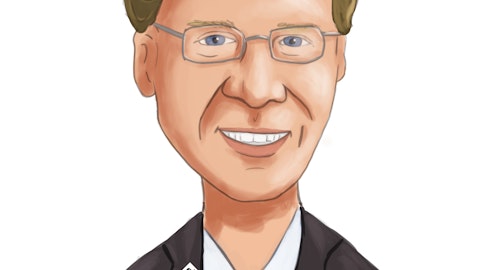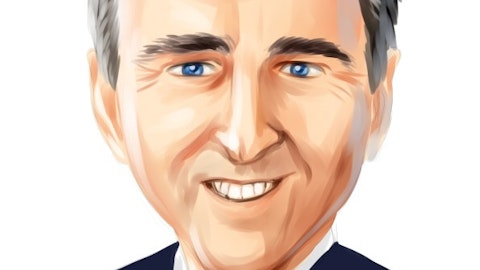First Commonwealth Financial Corporation (NYSE:FCF) Q3 2023 Earnings Call Transcript October 25, 2023
Operator: Ladies and gentlemen thank you for standing by. My name is Brent and I would like to welcome everyone to the First Commonwealth Financial Corporation Third Quarter 2023 Earnings Results Release Conference Call. At this time, all lines have been placed on mute to prevent any background noise. After the speakers’ remarks, there will be a question-and-answer session. [Operator Instructions] Thank you. It is now my pleasure to turn today’s call over to Mr. Ryan Thomas Vice President of Finance and Investor Relations. Sir please go ahead.
Ryan Thomas: Thank you, Brent and good afternoon everyone. Thank you for joining us today to discuss First Commonwealth Financial Corporation third quarter financial results. Participating on today’s call will be Mike Price, President and CEO; Jim Reske, Chief Financial Officer; Jane Grebenc, Bank President and Chief Revenue Officer; and Brian Karrip, our Chief Credit Officer. As a reminder, a copy of yesterday’s earnings release can be accessed by logging on to fcbanking.com and selecting the Investor Relations link at the top of the page. We’ve also included a slide presentation on our Investor Relations website with supplemental financial information that will be referenced during today’s call. Before we begin, I need to caution listeners that this call will contain forward-looking statements.

A successful business person confidently managing their finances on a mobile device. Editorial photo for a financial news article. 8k. –ar 16:9
Please refer to the forward-looking statements disclaimer on Page 3 of the slide presentation for a description of risks and uncertainties that could cause actual results to differ materially from those reflected in the forward-looking statements. Today’s call will also include non-GAAP financial measures. Non-GAAP financial measures should be viewed in addition, to and not as an alternative for, our reported results prepared in accordance with GAAP. A reconciliation of these measures can be found in the appendix of today’s slide presentation. With that I will turn the call over to Mike.
Mike Price: Thank you, Ryan and good afternoon everyone. For the third quarter of 2023, we are pleased to report core net income of $39.6 million, which translates to $0.39 of earnings per share, an ROA of 1.38%, and efficiency ratio of 53.4%. The NIM compressed nine basis points quarter-to-quarter to 3.76%. The rate of deposit cost increases is slowing and we believe that the NIM will stabilize going into the end of the year and continue to hold up in 2024. In a higher for longer environment, we believe that improvement in loan yields would likely outstrip growth in deposit cost. Operating expenses were up $1 million from the prior quarter, driven by costs associated with debit cards. Basically we had a one-time recognition of $900,000 in losses identified as part of a new automated system for processing debit card disputes.
In addition, we had a $600,000 increase in FDIC insurance compared to last quarter due to the acquisition of Centric and the associated deposit balances. This was somewhat offset by $1.1 million in decreases in salaries and benefits due in part to lower hospitalization expenses. Total loans grew some $102 million in the quarter or 4.6% annualized. Our Northern Ohio and Pittsburgh regions led the way geographically. From a line of business perspective, Commercial Banking and Equipment Finance were the key categories driving growth. We’ve metered loan growth commensurate with deposit growth each of the last three quarters. We have also strategically exited some non-relationship borrowers. End-of-period deposits grew $94.8 million or 4.2% annualized in the third quarter which is just short of the loan growth in the quarter.
Average deposits increased by 2.1% from last quarter. Strong regional contributors included Central Ohio and Community PA. This led to the loan-to-deposit ratio rising slightly from 96.4% to 96.7% in the quarter. We ended the quarter with solid credit metrics. Total delinquency was 25 basis points and non-performing loans as a percentage of total loans were flat at 54 basis points. Reserve coverage was a healthy 280%. Criticized loans and classified loans both improved. Net charge-offs annualized as a percentage of average loans were $4.4 million or 18 basis points of which approximately $1.2 million was related to the Centric acquisition. Provision expense for the third quarter totaled $5.9 million driven by loan growth and an additional $4.1 million in specific reserves, reflecting an updated appraisal on a non-accrual commercial loan.
The allowance for credit losses at quarter end totaled $134.3 million and the allowance as a percentage of loans was a healthy 1.51% which screens well we believe relative to our peers. On the digital front, adoption of credit score manager, a credit score manager tool and online banking has grown faster than expectations since launched in late April. We now have 30,000 users taking advantage of this robust financial wellness tool we believe is a best-in-class solution. The focus on our digital account openings has yielded expected growth so far in 2023 especially for checking accounts with an increase of over 190% in openings compared to the same period last year. We are now opening approximately one of every five accounts via the digital channel versus in person.
In closing, we’ve built enough strong revenue engines and have sufficient risk appetite to grow constructively provided we fund the asset growth with organic deposit growth. With that, I’ll turn it over to Jim Reske our CFO. Jim?
Jim Reske: Thanks, Mike. We have been able to produce solid deposit growth all year to fund our loan growth. On a year-to-date basis making no adjustments whatsoever for our Centric acquisition, loans have grown by $1.28 billion, while deposits have grown by nearly the same amount $1.24 billion. As a result, our loan-to-deposit ratio has been relatively stable in the mid-90s all year, but that masks our ability to grow our deposit base to fund our loan growth. Excluding the Centric acquisition, total loans have grown by $354 million year-to-date while period-end deposits excluding Centric have grown by $597 million. These deposits however came at a cost. In the third quarter, we saw our cost of deposits increased by 28 basis points, while our loan yields improved by only 21 basis points.
Deposit rotation from low-yield categories the higher cost deposit categories continued, but at a slower rate than last quarter. Fortunately, the overall pace of deposit cost increases continued to slow in the third quarter. Average cost of funds increased 48 basis points in the second quarter, but only increased 32 basis points in the third quarter. It’s too early to call the peak on deposit costs, but loan yields keep coming up nicely as well. New loans came on the books at an average rate of 7.43% in the third quarter, up nicely from 7.01% in the second quarter and 6.61% in the first quarter. The result as Mike said was 9 basis points of margin compression to 3.76%, a level which we still believe compares relatively well with peers. Our initial outlook for next year continues to show margin stability, though the range of potential outcomes is wider than usual due to the unpredictability of depositor behavior.
Our base case rate scenario calls for a Fed funds rate of about 4% by the end of next year. In this projection, the NIM actually expands a bit until mid-2024 and then fall slightly in the second half ending 2024 right about where it is now hence NIM stability. In a higher-for-longer rate scenario, you don’t see that dip in the second half of 2024. So the NIM is marginally better by about 5 basis points. These forecasts are highly dependent on assumptions regarding depositor behavior. For example, we have fairly conservative assumptions around the continued rotation of customer deposits in 2024 from low-cost categories into higher-yielding loans, higher costing loans even in a falling rate environment. So even in that falling rate environment, we assume that we’ll still have about 10% of the low-cost deposits rotate into higher cost categories in keeping with our experience in 2023.
And even with those assumptions, the 2024 NIM looks stable. By contrast in a higher from a longer rate environment, we get the benefit of higher loan yields in part, because the variable rate loan portfolio does not re-price downwards. But in that scenario, we’d expect more deposit rotation into higher cost freight categories, which would offset some of the benefit of higher rates. Fee income was little changed from last quarter. SBA gain on sale premiums have been under pressure, but our wealth division did better. We expect the income to be little changed next quarter. For next year, we are looking to grow SBA fee income to help offset slowing mortgage gain on sale income and the impact of lost interchange income due to the Durbin Amendment.
Non-interest expense was elevated in the second quarter in part due to costs associated with debit cards and related items as Mike described. Our expected non-interest expense is around $65 million to $67 million next quarter. We think expense pressures will continue in 2024, but we’re committed to keeping a lid on costs. We repurchased approximately 260,000 shares in the third quarter at a weighted average price of $12.36. We slowed share repurchases somewhat late in the second quarter to conserve capital. Tangible book value per share increased from $8.24 to $8.35, as retained earnings growth outstripped increased AOCI. Regulatory capital ratios improved slightly, while the tangible common equity ratio remained unchanged. And with that, I will turn it back over to Mike.
Mike Price: Operator, now we’ll turn it over for questions.
Operator: [Operator Instructions] Your first question comes from the line of Daniel Tamayo with Raymond James. Your line is open.
See also 20 States With Most Expensive Electricity In The US and Top 20 Brands Among Gen Z in the US by Mindshare.
Q&A Session
Follow First Commonwealth Financial Corp (NYSE:FCF)
Follow First Commonwealth Financial Corp (NYSE:FCF)
Daniel Tamayo: Good afternoon, everybody. Maybe we start on — I just want to make sure I heard your guidance correctly here Jim on the margin. Yeah. I mean, just — I guess, I can just tell you if the Fed funds rate ends about 4% in the year then the NIM is going to expand – sorry, yeah, expand during the year and then end the year around where it is now? Is there a contraction at the beginning of the year, or is that — did I hear that just expand and then. Okay.
Jim Reske: I’m sorry, I didn’t mean to talk over you. But yeah, you got to write the first. There’s a little bit of expansion from now. So you get some of the benefit of the loan portfolio the rate increases that have happened this year-to-date, and a positive replacement have been experiencing. So that helps to give you a little bit of expansion. But then rates — if the Fed funds rate falls that much by the end of next year there’s pressure in the variable rate portfolio that brings the overall NIM down a bit, so it trails off towards the end of next year and it ends next year and that projection actually exactly where it is right now in the system effect.
Daniel Tamayo: Okay. So you’ve got the margin going up next quarter essentially and then Fed dependent kind of as we move into 2024?
Jim Reske: Yes. With the big caveat that, these are all projections and we could always be wrong their forecast, right? So the hard thing to forecast has been depositor behavior, which is one of the reasons, I was trying to give a little more disclosure on some of the deposit behavior assumptions underlying the projections. But that’s right. You’ve got that right. In that projection, we think that, the low point for the margin is actually this quarter.
Daniel Tamayo: On that note, do you have the — what the margin was kind of in September, or just curious how it progressed during the third quarter.
Jim Reske: I don’t, but I’ll get it for you before the end of the call.
Daniel Tamayo: Okay. That sounds great. And then the — just wondering, I heard your comment on expense pressure continuing in 2024. Just curious, if you could put a little finer point on kind of how you’re thinking about that relative to maybe what you’ve done historically in terms of expense growth.
Mike Price: I’ll start there Daniel, great question. Just a week ago, we went through 30 operating plans for regions lines of business and business support units and with RESOLVE, we will try to get to a good point of operating leverage in next year’s budget. And that will include a combination of making the best assumptions we can about what’s going to happen in different optionalities for interest rates, really driving some more costs out and not — you have enough turnover in a bank, you don’t have to announce rips and things like that, but just in process — coupled with process improvements, but we just expect every line of business, every business unit every region to get better every year to grow deposits, to grow loans and create some operating leverage in their own respective budgets.
And we’re about 50% through that process. So we’ll land the plane here in the next 30 days. And — but that’s the goal. And if you look at our track record over the last 11 or 12 years, we’re pretty close or good at that. And if we miss, it’s not by much.
Daniel Tamayo: All right. Terrific. I appreciate the color. I’ll step back.
Operator: Your next question comes from the line of Michael Perito with KBW. Your line is open.
Michael Perito: Hey good afternoon guys. Thanks for taking my questions. I wanted to circle back on the margin conversation a little bit. I was curious if you guys can maybe give us a little incremental color in terms of like what the incremental spread is on your loan and deposit books today. So meaning, like your blended commercial loan yield on new originations against kind of your incremental dollar of deposits and where that spread is today? And it would seem like based on your margin guidance that you guys feel a bit more confident about being able to maintain or grow that spread moving forward now. But just curious, if I’m interpreting that correctly. And any detail there would be helpful.
Mike Price: Go ahead Jim.
Jim Reske: I think you’re talking about — well, new loan spreads like on corporate loans I think are holding up very nicely.
Mike Price: They are and in fact our biggest category of growth is commercial variable and our spreads there on advances and really all in or well in excess of 8%.
Michael Perito: Okay. And on the incremental funding side roughly where you guys kind of at today against that excess 8% figure?
Jim Reske: Yes. Incremental funding is going to be driven by the kind of deposit specials we have out right now, which is going to be between 4% and 5%. Current CD special time deposit specials are right about 5% and money market specials are between 4% and 4.5%.
Michael Perito: Okay. All right. So I mean it sounds like then the incremental spread is very supportive of kind of the margin which I guess backing into your commentary Jim to the prior question about how you think this could be the bottom for the NIM. I mean that — those facts would seem to be very supportive of that. I mean is that kind of the build up in terms of your projections?
Jim Reske: Yes I think that’s right. And just to be credit clear, the figure micro-sorting the yield on some of the corporate categories. If the overall yield and everything coming in is 7.43% in the quarter and your marginal cost of funds is still in the 4% to 5% range, that does kind of support the continued stability of the NIM.
Mike Price: Yes and we’ve pivoted, we’re supporting growth in categories quite frankly that have the best spread and we’re really believers in all of our businesses, but there’s times where we’ve pinched some of those businesses that have lower yields at this time. We want to keep our producers looking forward, but we’re putting on assets in the most attractive categories generally.
Michael Perito: That’s helpful. And then, if we think — as we start and I realize you’re not really providing 2024 guided full yet. But as we think about the growth opportunities next year, it seems to me like it’s kind of a balance between your appetite for growth and customers’ appetite for taking credit, right? And so, I mean on the one hand, it seems like your balance sheet is very well positioned if the spreads and the risk-adjusted returns are within your comfort level, you guys have room to grow loans on a net basis pretty at least mid-single digits next year without putting too much stress on really anything. But I guess the flip side of that question is, do you think there’s enough customer appetite with for example corporate yields north of 8% to drive that type of production based on what you’re hearing and seeing today? And I would love just some color on kind of those two sides of the equation as we think about loan growth for 2024 for you guys?




